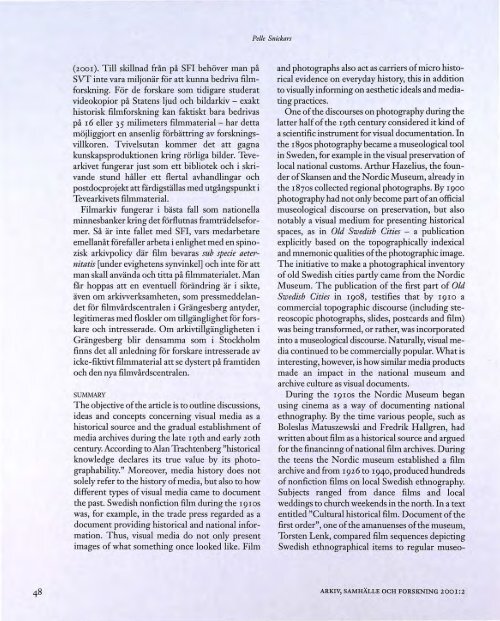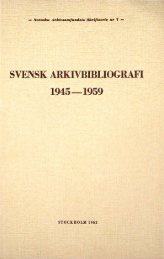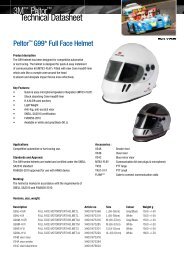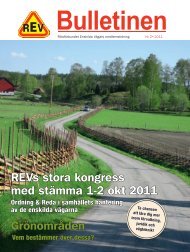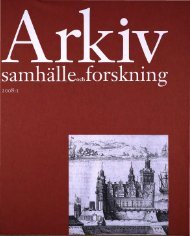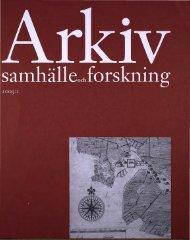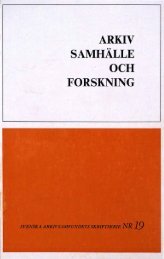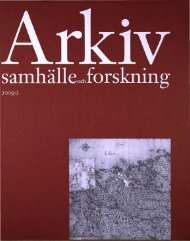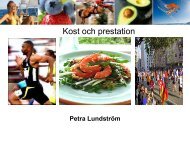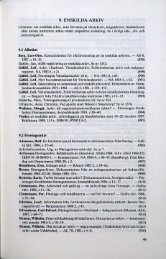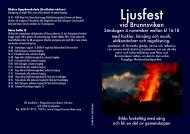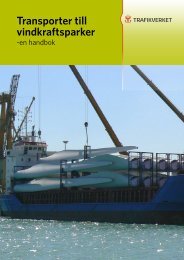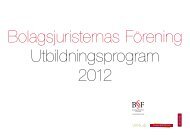Arkiv för ljud och bild - Visa filer
Arkiv för ljud och bild - Visa filer
Arkiv för ljud och bild - Visa filer
You also want an ePaper? Increase the reach of your titles
YUMPU automatically turns print PDFs into web optimized ePapers that Google loves.
(woi). Till skillnad från på SFI behöver man på<br />
SVT inte vara miljonär <strong>för</strong> att kunna bedriva filmforskning.<br />
För de forskare som tidigare studerat<br />
videokopior på Statens <strong>ljud</strong> <strong>och</strong> <strong>bild</strong>arkiv - exakt<br />
historisk filmforskning kan faktiskt bara bedrivas<br />
på I6 eller 35 Inilimeters filmmaterial-har detta<br />
möjliggjort en ansenlig <strong>för</strong>bättring av forskningsvillkoren.<br />
Tvivelsutan kommer det att gagna<br />
kunskapsproduktionen kring rörliga <strong>bild</strong>er. Tevearkivet<br />
fungerar just som ett bibliotek <strong>och</strong> i skrivande<br />
stund håller ett flertal avhandlingar <strong>och</strong><br />
postdocprojekt att färdigställas med utgångspunkt i<br />
Tevearkivets filmmateriaL<br />
Filmarkiv fungerar i bästa fall som nationella<br />
minnesbanker kring det <strong>för</strong>flutnas framträdelseformer.<br />
Så är inte fallet med SFI, vars medarbetare<br />
emellanåt <strong>för</strong>efaller arbeta i enlighet med en spinozisk<br />
arkivpolicy där film bevaras sub specie aeternitatis<br />
[under evighetens synvinkel] <strong>och</strong> inte <strong>för</strong> att<br />
man skall använda <strong>och</strong> titta på filmmaterialet. Man<br />
får hoppas att en eventuell <strong>för</strong>ändring är i sikte,<br />
även om arkivverksamheten, som pressmeddelandet<br />
<strong>för</strong> filmvårdscentralen i Grängesberg antyder,<br />
legitimeras med floskler om tillgänglighet <strong>för</strong> forskare<br />
<strong>och</strong> intresserade. Om arkivtillgängligheten i<br />
Grängesberg blir densamma som i Stockholm<br />
finns det all anledning <strong>för</strong> forskare intresserade av<br />
icke-fiktivt filmmaterial att se dystert på framtiden<br />
<strong>och</strong> den nya filmvårdscentralen.<br />
SUMMAR Y<br />
The objective of the artide is to outline discussions,<br />
ideas and concepts concerning visual media as a<br />
historical source and the gradual establishment of<br />
media archives during the late I 9th and early 20th<br />
century. According to Alan Trachtenberg "historical<br />
knowledge declares its true value by its photographability."<br />
Moreover, media history does not<br />
solely refer to the history of media, bu t also to how<br />
different types of visual media came to document<br />
the past. Swedish nonfiction film during the I9IOS<br />
was, for example, in the trade press regarded as a<br />
document providing historical and national information.<br />
Thus, visual media do not only present<br />
images of what something once looked like. Film<br />
Pelle Snickars<br />
and photographs also act as carriers of rnicro historical<br />
evidence on everyday history, this in addition<br />
to visually inforrning on aesthetic ideals and mediating<br />
practices.<br />
One of the discourses on photography during the<br />
latter half of the I 9th century considered i t kind of<br />
a scientific instrument for visual documentation. In<br />
the I89os photography became a museological tool<br />
in Sweden, for example in the visual preservation of<br />
local national customs. Arthur Hazelius, the fonnder<br />
of Skansen and the N or die Museum, already in<br />
the I87os collected regional photographs. By I9oo<br />
photography had not only become part of an official<br />
museological discourse on preservation, hut also<br />
notably a visual medium for presenting historical<br />
spaces, as in Old Swedish Cities - a publication<br />
explicitly based on the topographically indexical<br />
and mnemonic qualities of the photographic image.<br />
The initiative to make a photographical inventory<br />
of old Swedish cities partly came from the Nordie<br />
Museum. The publication of the first part of Old<br />
Swedish Cities in I9o8, testifies that by I9IO a<br />
commercial topographic discourse (including stereoscopic<br />
photographs, slides, postcards and film)<br />
was being transformed, or rather, was incorporated<br />
in to a museological discourse. Naturally, visual media<br />
continued to be commercially popular. What is<br />
interesting, however, is how similar media products<br />
made an impact in the national museum and<br />
archive culture as visual documents.<br />
During the I9IOS the Nordie Museum began<br />
using cinema as a way of documenting national<br />
ethnography. By the time various people, such as<br />
Boleslas Matuszewski and Fredrik Hallgren, had<br />
written about film as a historical source and argued<br />
for the financinng of national film archives. During<br />
the teens the Nordie museum established a film<br />
archive and from I926 to I94o, produced hundreds<br />
of nonfiction films on local Swedish ethnography.<br />
Subjects ranged from dance films and local<br />
weddings to church weekends in the north. In a text<br />
en ticled "Cultural historical film. Document of the<br />
first order", one of the amanuenses of the museum,<br />
Torsten Lenk, compared film sequences depicting<br />
Swedish ethnographical items to regular museo-<br />
ARKIV, SAMHÄLLE OCH FORSirniNG 200 I: 2


